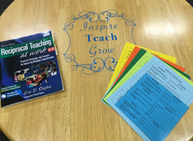|
Every so often an interaction with a student provides invaluable perspective and outlook on both teaching and life. Today was one of those instances.
I was in charge of today’s PBIS (Positive Behavior Interventions and Support) Assembly, where we recognize students who have shown the RAMS Way (Respect, Always Responsible, Manners, and Safety) over the past month. Students receive awards, VIP tickets, play games, and are reminded to show the RAMS Way everyday, both in and out of school. Since it is almost Halloween, I chose to do a Halloween themed “Eyeball relay race” which involved students using a spoon to carry a bouncy ball eyeball (I found them at Target!) around a series of cones. For the younger grades they just walked/ran around the cones, and the older grades we had them use scooters. It was prior to the older grades’ assembly that the perspective I mentioned earlier was experienced. You see, while drawing names for students to participate in the game, I drew the name of a student who happened to be on crutches. For a second I thought I should draw another name to replace the student, however at just that moment the student in question walked by. I asked them to stop by the table where I was drawing names, and let them know I had drawn their name for the game, explained what the game entailed, and asked if there was a classmate they would like to pick to go in their place. Expecting to hear the name of one of their friends, I was surprised when the student said “No, I am going to do the relay.” A little perplexed, I asked if they were sure, and the student quickly replied, “Mrs. Laird, I still have one good leg!” and walked away. Believe me when I say I felt about an inch tall! In that one statement, “I still have one good leg,” I learned so much and was reminded how harmful it can be to have a deficit mindset. I need to remember to focus on what I do have, what I can control, and always have a positive outlook. This memory will stick with me for the rest of my teaching career and life, and perhaps I’ll find a way to turn it into a children’s story or weave it into a professional book!
0 Comments
In my role as an Instructional Coach, I am frequently asked to support teachers in their work with students. Recently, an elementary student needed support with writing. This student had wonderful ideas to share, however classmates and the teacher were unable to decipher handwritten or typed stories. The classroom teacher knew there must be something to be done, and turned to me for support. Given the fact that we are a one-to-one technology device building, I have used Google’s speech-to-text tools (Voice Typing) before, and knew this would be a good place to start. A few days later, the student game to my office during writing time. After logging in to their Chromebook, the student opened a new Google Doc, clicked “tools” then “voice typing,” and their world opened! Immediately upon speaking and reading their rough draft aloud, the student paused the speech-to-text and looked at me with a grin on their face. “Mrs. Laird, do you know what this means?” the student asked. “My friends and my teacher will now be able to understand me and everyone will be able to read my stories!”
While Voice Tying isn’t new to me, and I have told other teachers about it, this was the first time I saw first hand a student see their world as a writer open up due to the tool. The next thirty minutes flew by as I watched the student become familiar with the intricacies of using Voice Typing, including remembering to say the type of punctuation, remember to pause periodically, and recognizing Google doesn’t automatically know how to spell the names of their friends. When it was time to go back to their classroom, the student told me how excited they were to take their writing notebook home over the weekend and type up other stories to share with friends. The thirty minutes I spent with this student reminded me the power technology has to open doors for students and allow them an outlet to share their voice, ideas, passions, and curiosity with the world.  For several years, Reciprocal Teaching has been one of my go-to strategies for reading. Over the past year I started using it in math instruction and am loving the results. In case you aren't familiar with Reciprocal Teaching, there are four strategies ("The Fab Four"): Predict, Question, Clarify, and Summarize. All four strategies are used within each lesson, and Reciprocal Teaching has an effect size of .74. Introducing the strategies can occur through read alouds (Lori has a great list in her book), or by using cards like the ones below. For more information, check out ASCD's Fab Four webpage, and Reciprocal Teaching at Work by Lori Oczkus. Through my Instructional Coach role, I have the opportunity to partner with teachers, and incorporating Reciprocal Teaching within reading and math is one of my favorite topics/goals. To support our work, I have created different resources related to Reciprocal Teaching, starting first with reading and later adding in math. Below, you can check out several of the resources I have created. I love the results I've seen from Reciprocal Teaching in reading and math, and cannot speak high enough of the strategies. If you would like support incorporating Reciprocal Teaching in your instruction, have questions, or would like copies of any resources, let me know.
|
Archives
October 2023
Categories
All
|



 RSS Feed
RSS Feed
